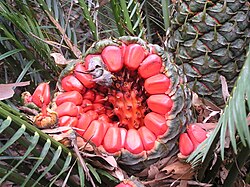

The sarcotesta is a fleshy seedcoat, [1] a type of testa. Examples of seeds with a sarcotesta are pomegranate, ginkgo and some cycad seeds. The sarcotesta of pomegranate seeds consists of epidermal cells derived from the integument, and there are no arils on these seeds. [2]